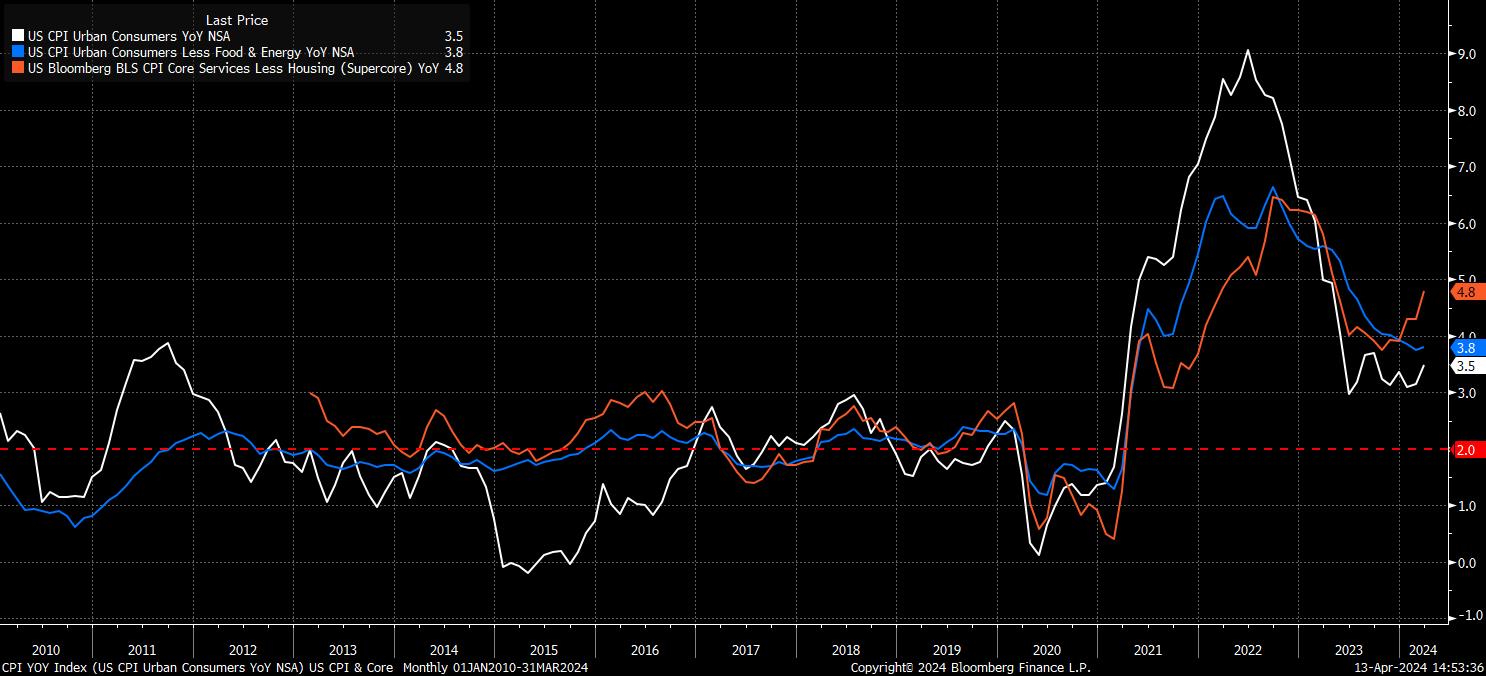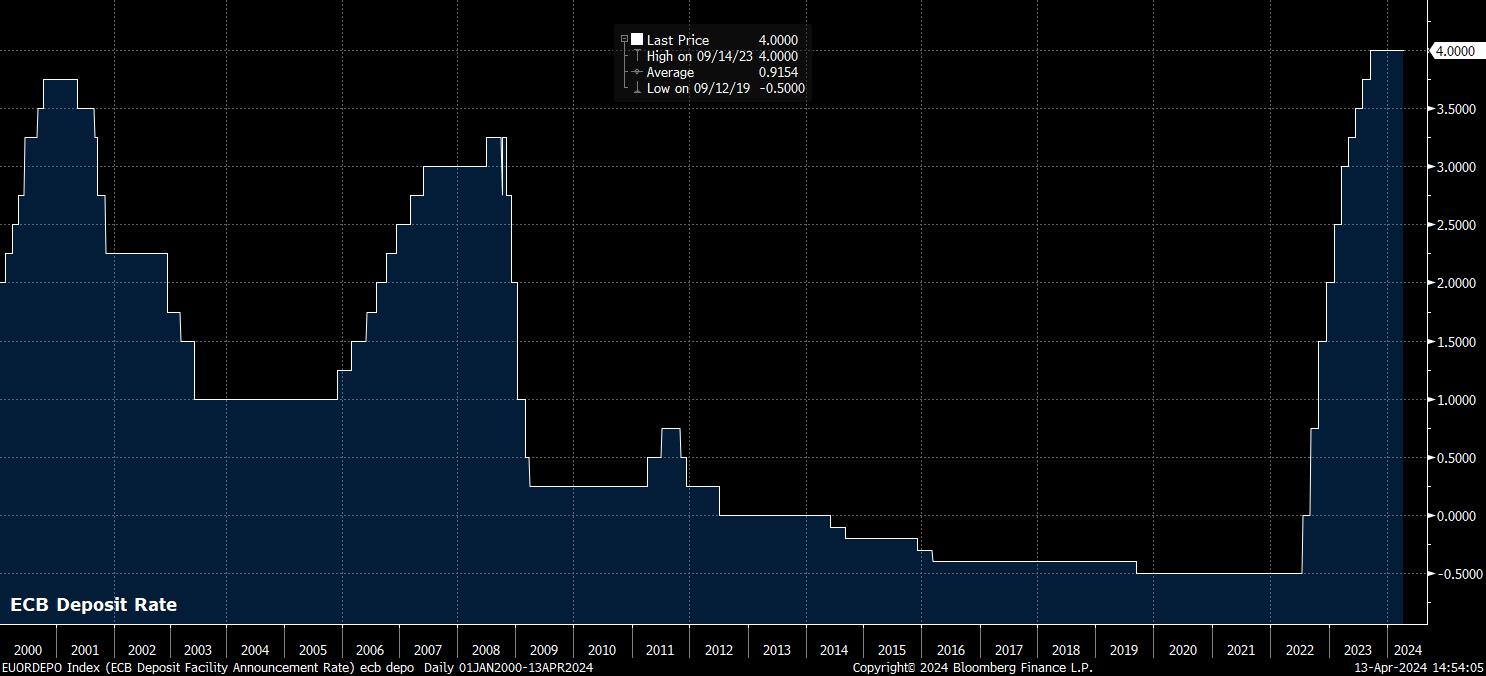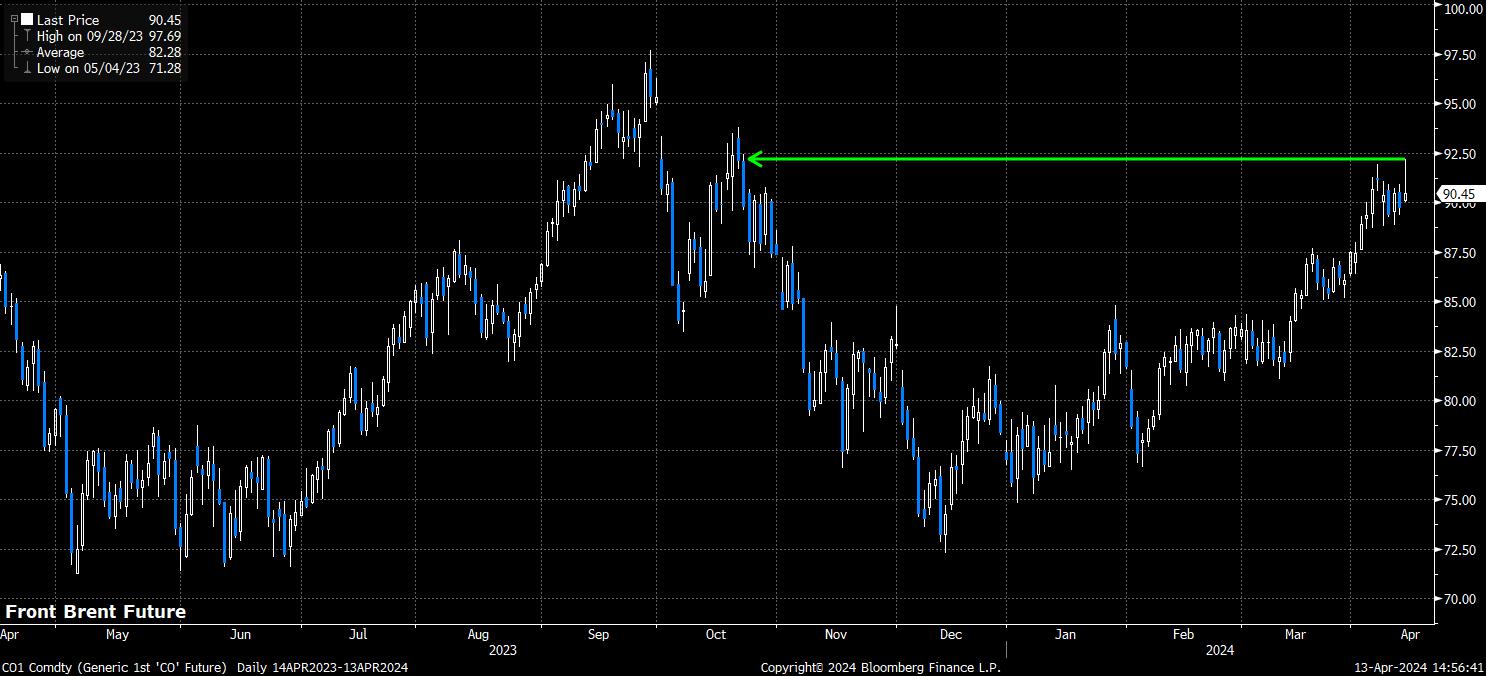Spread bets and CFDs are complex instruments and come with a high risk of losing money rapidly due to leverage. 73.7% of retail investor accounts lose money when trading spread bets and CFDs with this provider. You should consider whether you understand how spread bets and CFDs work, and whether you can afford to take the high risk of losing your money.
- English
- 中文版
Week Ahead Playbook: Policy Paths Diverge As Geopolitical Risk Rises

The Week That Was – Themes
Besides geopolitical developments, which we shall discuss momentarily, last week was one where markets were driven by shifting policy expectations, particularly after the hotter-than-expected March US CPI report pointed to persistent inflationary pressures, casting doubt on how soon the FOMC will begin to normalise policy.
Headline CPI rose 3.5% YoY last month, the 3rd straight print above consensus expectations, and above the 3.2% YoY pace seen in March, with much of this rise being driven by an increase in energy, and principally gasoline, prices. Excluding these, and food, core CPI rose 3.8% YoY, unchanged from the pace seen in February, while the so-called ‘supercore’ inflation gauge – which pertains to core services inflation, excluding housing costs – surged 4.8% YoY, an 11-month high.

Meanwhile, CPI was also hot on an MoM basis, with both headline and core indices rising 0.4% on this basis, again both being unchanged from the pace seen in February. Annualising this data, which helps to produce a somewhat clearer picture of current underlying inflationary trends, points to a 3-month annualised headline CPI rate of 4.6%, the highest since November 2022, and a 3-month annualised core rate of 4.5%, the highest since Q2 23.
In short, no matter how you choose to ‘slice and dice’ the figures, CPI inflation is proving stickier than expected, and significant disinflationary progress remains elusive. Furthermore, while hot prints in both January and February had been explained away as ‘noise’, it is now almost impossible to describe the figures as anything other than a worrying trend.
Granted, last week’s PPI figures were a touch softer than expected, with the headline gauge rising 2.1% YoY vs. a 2.2% YoY consensus, though such a pace continues to represent a substantial lift from the 1.6% YoY rate seen in February. This is particularly worrying when one considers that progress on services disinflation has stalled for the last six months, while goods disinflation has recently turned into goods deflation. Risks to goods prices, however, appear increasingly tilted to the upside, particularly amid ongoing and escalating geopolitical tensions, in turn posing a risk that headline inflation also re-accelerates.
Data of this ilk, particularly when coupled with the strong pace of hiring, and tight nature of the US jobs market, has led some to beg the question of whether the FOMC need to even be considering rate cuts at this stage. Said cuts are still likely, however, though recent data will do little to give policymakers the “confidence” they seek that inflation is returning towards 2% in order to deliver the first cut. Unsurprisingly, with ‘higher for longer’ back on the cards, swaps have pushed back the timing of the first cut, now fully pricing a 25bp reduction for September, while seeing just under 50bp of easing in 2024 as a whole – quite the hawkish repricing compared to the 65bp seen a week ago, and the whopping 150bp of cuts priced at the start of the year!
If the FOMC outlook has become more uncertain, on this side of the Atlantic, the ECB’s likely rate path was cemented last week.
While the Governing Council did not explicitly pre-commit to a rate cut in June, the easing cycle is still set to begin at the next meeting, particularly after a dovish revision to the policy statement noting that “it would be appropriate to reduce the current level of monetary policy restriction” if the updated inflation outlook, part of the June staff macroeconomic projections, were to further increase policymakers’ confidence that inflation is converging to the 2% target “in a sustained manner”.
President Lagarde also repeated her previous guidance that the ECB will know “a lot more” by the time of the next policy confab, while also flagging that a “very large majority” of GC members wanted to wait for the June meeting before firing the starting gun on the easing cycle, even if “a few” members felt confident enough on the inflation outlook to have sought a cut last Thursday. In truth, if the ECB hadn’t boxed themselves into a June cut at the March meeting, they would probably have ended up delivering a rate cut last week in any case, with the economic recovery remaining fragile, growth risks still tilted to the downside, and inflation fading faster than expected.
In any case, a clear FOMC-ECB divergence has now opened, with risks to the Fed outlook tilting in an increasingly hawkish direction as inflation remains sticky, and risks to the ECB outlook tilting further to the dovish end of the spectrum, even if explicit comments on the rate path beyond June have been thin on the ground thus far. This should continue to apply downward pressure to the EUR, with EUR/USD likely to continue to grind lower for some time to come.

Sticking with the monetary policy world, last week also brought updates from the Bank of Canada, and the Reserve Bank of New Zealand. While the RBNZ issued what was, largely, a ‘copy and paste’ of the prior statement, noting that the balance of risks remains little changed, and that a continued restrictive policy stance is “necessary”, the BoC provided a little more intrigue.
Policymakers flagged that they ‘see what they need to’ on inflation, while also noting a desire to see said developments turn into a longer trend, to be “sure” that a recent dip in core inflation isn’t temporary. Couple this with an 0.2pp downward revision to the 2024 CPI forecast, with inflation now seen at 2.6% this year, along with Governor Macklem explicitly noting that June is “in the realm of possibilities” for a rate cut, and a reduction in early-summer seems to now be the base case.
This provides helpful reinforcement of the idea that the FOMC will become something of a hawkish outlier among G10 central banks, as cuts commence elsewhere, but sticky Stateside inflation prevents Powell & Co from cutting as soon. Subsequently, this should see yield spreads continue to move in the greenback’s favour, and help the dollar to gain further ground against peers, with any dips likely to be shallow.
The Week That Was – Markets
Certainly, the dollar was in demand last week, with the dollar index (DXY) rallying just shy of 1.75% over the last five trading days, notching its best one-week advance since September 2022, chalking up a series of fresh YTD highs in the process.
_D_2024-04-13_14-54-26.jpg)
While the aforementioned hawkish repricing of Fed policy expectations drove a significant degree of this move, the ratcheting up of geopolitical risk seen during Friday’s session also helped to spark further haven demand for the buck, and also saw key levels break elsewhere in the G10 FX world – cable trading below 1.25, the JPY notching new 34-year lows, the EUR dipping under 1.07, and the AUD giving up the .65 figure.
Following an alleged Israeli strike on senior Iranian military commanders at a Syrian compound last week, market participants were spooked as the week drew to a close by a deluge of reporting that a potential Iranian retaliatory strike on Israel could be “imminent”, with intelligence reports noting that Israel was braced for such an attack to come “within days”. Such an Iranian attack did come on Saturday, in the form of a drone and missile barrage towards Israel, after which Iran noted in a statement at the UN that it considered that the "matter can be concluded".
In rapid fashion, these Friday headlines saw geopolitical concerns surge back to the forefront of traders’ minds, and sparked a ‘classic’ bout of risk aversion into the weekend, with participants logically seeking to de-risk as much as possible, concerned about the potential for gapping risk upon the market re-open, if an attack were to take place, and the situation deteriorate. Put simply, capital preservation became the priority.
Gold was, initially, a significant beneficiary of these haven flows, with the yellow metal building further upon recent gains, to trade north of $2,400/oz for the first time ever, before experiencing a rather brutal late-day reversal which saw price end the day almost exactly where it had begun. While it feels too early, and frankly foolish, to call an end to the recent rally, particularly in such a fluid geopolitical environment, failure to sustain gains may worry the bulls a little.
_D_2024-04-13_14-55-20.jpg)
Crude saw a similar move, with both Brent and WTI initially spiking higher as headlines crossed, notching fresh highs since last October, before retracing much of the earlier gains, albeit with the former settling on Friday above $90bbl for the second week in a row.

This ‘traditional’ risk aversion also fed through into the Treasury space, which saw a rally across the curve on Friday, albeit one which couldn’t prevent all maturities ending the week lower, with the 2-year yield rising around 15bp over the last five trading days, a reflection of the hawkish shift in Fed expectations, as the curve itself further bear flattened.
A similar story was seen in equities, too, though sentiment was also somewhat pressured by a rather sub-par start to Q1 earnings season, as banks such as JPMorgan and Wells Fargo disappointed on net interest income, a sign that the beneficial impact of higher rates may be fading, even as capital markets performance, especially that of Citigroup, remains resilient.
In any case, the S&P 500 ended the week in negative territory, slipping just over 1.5%, recording back-to-back weekly declines for the first time in a month. The tech-heavy Nasdaq 100 also slipped, losing around 0.65%, for a third weekly loss, the index’s worst run since last August.
Nevertheless, despite these losses, increasing geopolitical tensions, and the hawkish Fed repricing, the ‘path of least resistance’ should continue to lead higher for equities. Buying interest may well be found around the 50-day moving average in the S&P 500, just south of Friday’s close, and a level beneath which the front future hasn’t traded since last November.

While the March CPI report was clearly not the news that policymakers were seeking, it is still the case that the next move in the fed funds rate will be a cut, albeit a cut somewhat later than had been previously expected. As many policymakers have noted since the data dropped, stronger than expected inflation figures will mean the duration at which the fed funds rate remains at its terminal level increases, rather than necessitating another rate hike. Hence, policy is still on track to loosen as the year progresses – whether that first cut comes in June, or July, or September, cuts are still on the way.
One must add on top of this the idea that the ‘Fed put’ is now alive once more, with the FOMC willing and able to step in with more aggressive cuts, and/or targeted liquidity injections were things to turn sour from a macroeconomic or financial stability standpoint. Powell & Co. have the market’s back once more.
Of course, this is not to say that pullbacks, or even a deeper correction, won’t occur. Instead, it is to say that the medium-term balance of probability continues to point towards further gains, with the supportive policy backdrop enhanced by continued strong economic growth, with this above-potential growth also likely to see earnings and revenue growth remain solid, further helping the market to gain ground.
The Week Ahead
It goes without saying that geopolitical developments will be traders’ primary focus over the course of the week ahead, with participants remaining attuned to developments in the Middle East. Any further escalation in tensions would likely see renewed haven demand, akin to the playbook which went into force on Friday afternoon.
Beyond this, however, another intriguing week of economic events awaits, even if the data docket is a little quieter than it has been of late.
It is here in the UK where things are, perhaps, most interesting, with the ONS set to release the latest jobs (Tues), inflation (Weds) and retail sales (Fri) figures this week. Although concerns remain over the accuracy of the employment data, unemployment is expected to have risen to 4.0% in the three months to February, while earnings growth should continue to cool, with regular pay seen rising 5.5% YoY over the same period, 0.1pp slower than previously.
Inflation, of course, remains the primary focus for the BoE, however, and is set to have cooled further in March. Headline CPI is seen rising 3.1% YoY, 0.1pp below the February rate, while core inflation should cool to 4.1% YoY, from 4.5% prior. This should leave the UK on track to achieve the 2% inflation target, albeit briefly, in the spring, while a cooler than expected print would likely see the market dovishly reprice BoE expectations, with the GBP OIS curve currently assigning a roughly 50:50 chance of a June rate cut from the ‘Old Lady’.

Inflation figures are also due from plenty of other G10 economies this week, including Canada, Japan, and New Zealand. The Canadian figures, due Tuesday, are of considerably more interest than usual, given the openness with which BoC Governor Macklem discussed a June rate cut last week.
Other notable data points due this week include the latest Australian jobs report, which is likely to show a +10k rise in employment in March, though unemployment is set to rise to 3.9%, from 3.7%, resuming the trend of higher unemployment seen since last September. Meanwhile, China release a slew of activity figures, including last month’s industrial production and retail sales stats, as well as Q1 GDP. The economy is expected to have grown 4.8% YoY in the first quarter, slower than the 5.2% YoY pace seen at the end of 2023, though a healthy pinch of salt is – as always – required when interpreting this data.
In the US, this week’s data highlight stands as Monday’s retail sales report, with sales set to have risen 0.4% MoM in March, on both the headline and control group metrics, further reinforcing the case for ‘US exceptionalism’ continuing, as growth remains anaemic elsewhere in DM. A busy slate of Fed speakers also awaits, including Fed Chair Powell on Tuesday, plus 14 other policymaker appearances (times/dates below are for London).
Last, but by no means least, earnings season continues this week, with 44 of the S&P 500’s constituents set to report, including 6 members of the Dow. Standout releases include the continuation of bank earnings with Goldman Sachs (Mon), Morgan Stanley and Bank of America (both Tues) set to report, along with the embattled UnitedHealth (also Tues), the largest stock in the Dow by weight, and Netflix reporting after Thursday’s market close.
In summary, while geopolitical headlines will naturally steal significant market attention, and provoke substantial reaction if indicative of any escalation, market moves of this ilk are likely to be relatively short-lived. Overall, the path of least resistance continues to lead higher for equities, as discussed, and for the dollar, over the medium-term, as widening policy divergence continues to support the latter.
Related articles
The material provided here has not been prepared in accordance with legal requirements designed to promote the independence of investment research and as such is considered to be a marketing communication. Whilst it is not subject to any prohibition on dealing ahead of the dissemination of investment research we will not seek to take any advantage before providing it to our clients.
Pepperstone doesn’t represent that the material provided here is accurate, current or complete, and therefore shouldn’t be relied upon as such. The information, whether from a third party or not, isn’t to be considered as a recommendation; or an offer to buy or sell; or the solicitation of an offer to buy or sell any security, financial product or instrument; or to participate in any particular trading strategy. It does not take into account readers’ financial situation or investment objectives. We advise any readers of this content to seek their own advice. Without the approval of Pepperstone, reproduction or redistribution of this information isn’t permitted..



